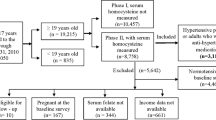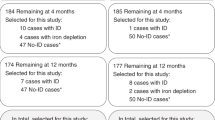Abstract
Objective:
The incidence of cerebrovascular accidents (CVA) occurring perinatally is relatively high and aspects of the multifactorial pathophysiology remain unclear. Elevated homocysteine concentrations have been shown to be associated with an increased risk for CVA in children and even in newborns. We studied the possible homocysteine lowering effect of folinic acid in newborns.
Method:
We included 37 newborns in our prospective randomized folinic acid (given as 5-formyltetrahydrofolate) intervention study from patients admitted to our neonatal intensive care unit (18 controls, 19 intervention group). We measured total homocysteine (tHcy) and plasma folate concentrations at three time points (baseline, 1 and 2 weeks after intervention). The intervention group was treated with folinic acid (70 μg/kg/day) for 2 weeks. We calculated median concentrations (25th and 75th percentiles).
Results:
Median tHcy concentrations at the three time points did not differ from each other in the control group nor in the intervention group. We also could not observe different tHcy concentrations between both groups. Plasma folate concentrations increased in the intervention group (mean increase 167% (95% confidence interval (CI) −291, 625)) compared with control group (mean increase −12% (95% CI −132, 108)), P for treatment effect: 0.03.
Conclusion:
We could not demonstrate a homocysteine lowering effect of folinic acid administration in newborns. This indicates that one carbon metabolism in newborns differs form adults. Cobalamin might be a better strategy to lower tHcy concentrations in newborns.
This is a preview of subscription content, access via your institution
Access options
Subscribe to this journal
Receive 12 print issues and online access
$259.00 per year
only $21.58 per issue
Buy this article
- Purchase on Springer Link
- Instant access to full article PDF
Prices may be subject to local taxes which are calculated during checkout

Similar content being viewed by others
References
Akar N, Akar E, Ozel D, Deda G, Sipahi T (2001). Common mutations at the homocysteine metabolism pathway and pediatric stroke. Thromb Res 102, 115–120.
Bjorke Monsen AL, Ueland PM (2003). Homocysteine and methylmalonic acid in diagnosis and risk assessment from infancy to adolescence. Am J Clin Nutr 78, 7–21.
Bjorke Monsen AL, Ueland PM, Vollset SE, Guttormsen AB, Markestad T, Solheim E et al. (2001). Determinants of cobalamin status in newborns. Pediatrics 108, 624–630.
Bjorke-Monsen AL, Torsvik I, Saetran H, Markestad T, Ueland PM (2008). Common metabolic profile in infants indicating impaired cobalamin status responds to cobalamin supplementation. Pediatrics 122, 83–91.
Brattstrom LE, Israelsson B, Jeppsson JO, Hultberg BL (1988). Folic acid—an innocuous means to reduce plasma homocysteine. Scand J Clin Lab Invest 48, 215–221.
Buccianti G, Bamonti CF, Patrosso C, Corghi E, Novembrino C, Baragetti I et al. (2001). Reduction of the homocysteine plasma concentration by intravenously administered folinic acid and vitamin B(12) in uraemic patients on maintenance haemodialysis. Am J Nephrol 21, 294–299.
Couto FD, Moreira LM, Dos Santos DB, Reis MG, Goncalves MS (2007). Folate, vitamin B12 and total homocysteine levels in neonates from Brazil. Eur J Clin Nutr 61, 382–386.
den Heijer M, Rosendaal FR, Blom HJ, Gerrits WB, Bos GM (1998). Hyperhomocysteinemia and venous thrombosis: a meta-analysis. Thromb Haemost 80, 874–877.
Ducloux D, Aboubakr A, Motte G, Toubin G, Fournier V, Chalopin JM et al. (2002). Hyperhomocysteinaemia therapy in haemodialysis patients: folinic versus folic acid in combination with vitamin B6 and B12. Nephrol Dial Transplant 17, 865–870.
Fokkema MR, Woltil HA, van Beusekom CM, Schaafsma A, Dijck-Brouwer DA, Muskiet FA (2002). Plasma total homocysteine increases from day 20 to 40 in breastfed but not formula-fed low-birthweight infants. Acta Paediatr 91, 507–511.
Fuller NJ, Bates CJ, Cole TJ, Lucas A (1992). Plasma folate levels in preterm infants, with and without a 1 mg daily folate supplement. Eur J Pediatr 151, 48–50.
Gellekink H, den Heijer M, Heil SG, Blom HJ (2005). Genetic determinants of plasma total homocysteine. Semin Vasc Med 5, 98–109.
Grabowski EF, Buonanno FS, Krishnamoorthy K (2007). Prothrombotic risk factors in the evaluation and management of perinatal stroke. Semin Perinatol 31, 243–249.
Guerra-Shinohara EM, Paiva AA, Rondo PH, Yamasaki K, Terzi CA, D’Almeida V (2002). Relationship between total homocysteine and folate levels in pregnant women and their newborn babies according to maternal serum levels of vitamin B12. BJOG 109, 784–791.
Hauser AC, Hagen W, Rehak PH, Buchmayer H, Fodinger M, Papagiannopoulos M et al. (2001). Efficacy of folinic versus folic acid for the correction of hyperhomocysteinemia in hemodialysis patients. Am J Kidney Dis 37, 758–765.
Herrmann W, Herrmann M, Obeid R (2007). Hyperhomocysteinaemia: a critical review of old and new aspects. Curr Drug Metab 8, 17–31.
Hogeveen M, Blom HJ, Van Amerongen M, Boogmans B, van Beynum I, van de Bor M (2002). Hyperhomocysteinemia as risk factor for ischemic and hemorrhagic stroke in newborn infants. J Pediatr 141, 429–431.
Homocysteine Lowering Trialists’ Collaboration (2000). Lowering blood homocysteine with folic acid-based supplements: meta-analysis of randomised trials. Indian Heart J 52, S59–S64.
Homocysteine Lowering Trialists’ Collaboration (2005). Dose-dependent effects of folic acid on blood concentrations of homocysteine: a meta-analysis of the randomized trials. Am J Clin Nutr 82, 806–812.
Hongsprabhas P, Saboohi F, Aranda JV, Bardin CL, Kovacs LB, Papageorgiou AN et al. (1999). Plasma homocysteine concentrations of preterm infants. Biol Neonate 76, 65–71.
Jyothi S, Misra I, Morris G, Benton A, Griffin D, Allen S (2007). Red cell folate and plasma homocysteine in preterm infants. Neonatology 92, 264–268.
Karademir F, Suleymanoglu S, Ersen A, Aydinoz S, Gultepe M, Meral C et al. (2007). Vitamin B12, folate, homocysteine and urinary methylmalonic acid levels in infants. J Int Med Res 35, 384–388.
Minet JC, Bisse E, Aebischer CP, Beil A, Wieland H, Lutschg J (2000). Assessment of vitamin B-12, folate, and vitamin B-6 status and relation to sulfur amino acid metabolism in neonates. Am J Clin Nutr 72, 751–757.
Molloy AM, Mills JL, McPartlin J, Kirke PN, Scott JM, Daly S (2002). Maternal and fetal plasma homocysteine concentrations at birth: the influence of folate, vitamin B12, and the 5,10-methylenetetrahydrofolate reductase 677C-->T variant. Am J Obstet Gynecol 186, 499–503.
Raju TN, Nelson KB, Ferriero D, Lynch JK (2007). Ischemic perinatal stroke: summary of a workshop sponsored by the National Institute of Child Health and Human Development and the National Institute of Neurological Disorders and Stroke. Pediatrics 120, 609–616.
Refsum H, Grindflek AW, Ueland PM, Fredriksen A, Meyer K, Ulvik A et al. (2004). Screening for serum total homocysteine in newborn children. Clin Chem 50, 1769–1784.
Schulpis K, Spiropoulos A, Gavrili S, Karikas G, Grigori C, Vlachos G et al. (2004). Maternal—neonatal folate and vitamin B12 serum concentrations in Greeks and in Albanian immigrants. J Hum Nutr Diet 17, 443–448.
Sirachainan N, Tapanapruksakul P, Visudtibhan A, Chuansumrit A, Cheeramakara C, Atamasirikul K et al. (2006). Homocysteine, MTHFR C677 T, vitamin B12, and folate levels in Thai children with ischemic stroke: a case-control study. J Pediatr Hematol Oncol 28, 803–808.
te Poele-Pothoff MT, van den Berg M, Franken DG, Boers GH, Jakobs C, de Kroon I et al. (1995). Three different methods for the determination of total homocysteine in plasma. Ann Clin Biochem 32 (Part 2), 218–220.
Touam M, Zingraff J, Jungers P, Chadefaux-Vekemans B, Drueke T, Massy ZA (1999). Effective correction of hyperhomocysteinemia in hemodialysis patients by intravenous folinic acid and pyridoxine therapy. Kidney Int 56, 2292–2296.
Ueland PM, Refsum H (1989). Plasma homocysteine, a risk factor for vascular disease: plasma levels in health, disease, and drug therapy. J Lab Clin Med 114, 473–501.
van Beynum I, den Heijer M, Thomas CM, Afman L, van Oppenraay ED, Blom HJ (2005). Total homocysteine and its predictors in Dutch children. Am J Clin Nutr 81, 1110–1116.
van Beynum I, Smeitink JA, den Heijer M, te Poele Pothoff MT, Blom HJ (1999). Hyperhomocysteinemia: a risk factor for ischemic stroke in children. Circulation 99, 2070–2072.
van der Linden I, Afman LA, Heil SG, Blom HJ (2006). Genetic variation in genes of folate metabolism and neural-tube defect risk. Proc Nutr Soc 65, 204–215.
van Oort FV, Melse-Boonstra A, Brouwer IA, Clarke R, West CE, Katan MB et al. (2003). Folic acid and reduction of plasma homocysteine concentrations in older adults: a dose-response study. Am J Clin Nutr 77, 1318–1323.
Verhoef P, de Groot LC (2005). Dietary determinants of plasma homocysteine concentrations. Semin Vasc Med 5, 110–123.
Wang X, Qin X, Demirtas H, Li J, Mao G, Huo Y et al. (2007). Efficacy of folic acid supplementation in stroke prevention: a meta-analysis. Lancet 369, 1876–1882.
Wilcken DE, Dudman NP, Tyrrell PA, Robertson MR (1988). Folic acid lowers elevated plasma homocysteine in chronic renal insufficiency: possible implications for prevention of vascular disease. Metabolism 37, 697–701.
Yango A, Shemin D, Hsu N, Jacques PF, Dworkin L, Selhub J et al. (2001). Rapid communication: L-folinic acid versus folic acid for the treatment of hyperhomocysteinemia in hemodialysis patients. Kidney Int 59, 324–327.
Author information
Authors and Affiliations
Corresponding author
Ethics declarations
Competing interests
The authors declare no conflict of interest.
Rights and permissions
About this article
Cite this article
Hogeveen, M., den Heijer, M., Schonbeck, Y. et al. The effect of folinic acid supplementation on homocysteine concentrations in newborns. Eur J Clin Nutr 64, 1266–1271 (2010). https://doi.org/10.1038/ejcn.2010.155
Received:
Revised:
Accepted:
Published:
Issue Date:
DOI: https://doi.org/10.1038/ejcn.2010.155
Keywords
This article is cited by
-
Folic acid alleviates jaundice of phenylhydrazine (PHA)-induced neonatal rats by reducing Lys-homocysteinylation of albumin
Cell Biology and Toxicology (2021)
-
Role of thrombophilic factors in full-term infants with neonatal encephalopathy
Pediatric Research (2013)



